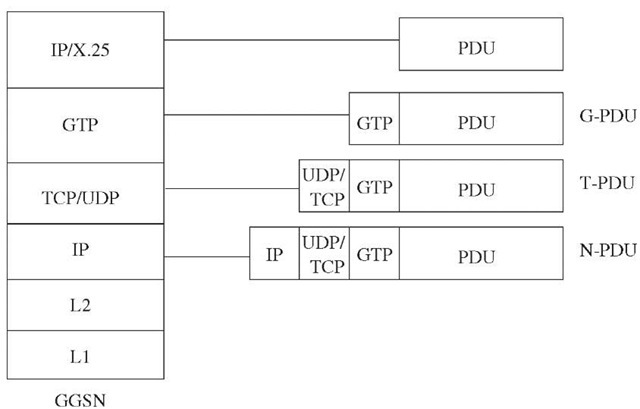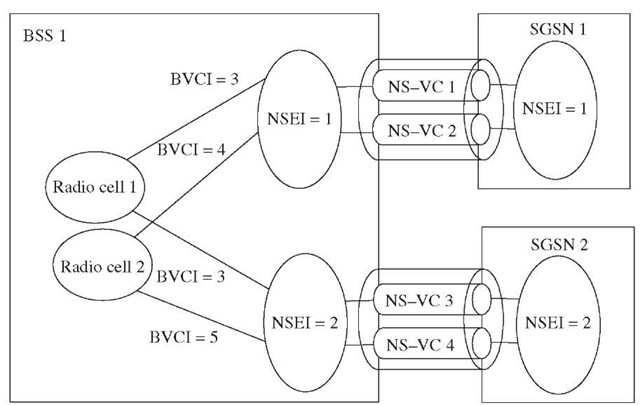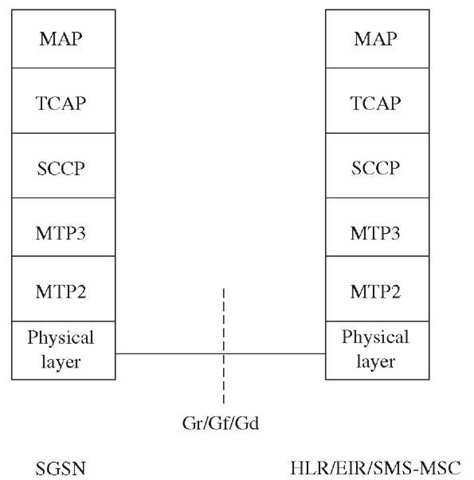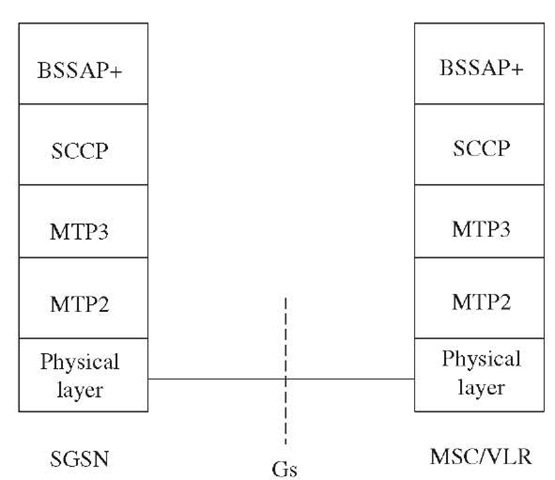User plane
Figure 4-3 shows the protocol architecture of the GPRS user/transmission plane. The user plane provides user information transfer and associated signaling procedures, e.g., flow control and error detection and correction.
GGSN-SGSN. The user data packets arriving at the SGSN from the MS or at the GGSN from the external PDN are encapsulated before onward transmission within the GPRS backbone network. The GPRS tunneling protocol for user plane (GTP-U) is used to tunnel the user data between SGSN and GGSN over the Gn interface and between GSNs from different PLMNs over the Gp interface. GTP carries the user packets, i.e., X.25 or IP.
TCP/UDP is used to transport GTP packets within the GPRS intra-PLMN backbone. TCP carries GTP PDUs (G-PDUs) for protocols that require a reliable data link, e.g., X.25. UDP carries G-PDUs for protocols that do not require a reliable data link, e.g., IP.
Figure 4-3 Protocol architecture of the GPRS user/transmission plane.
Below UDP/TCP, IP is used as a network layer protocol to route the packets from the upper layer through the backbone network. Currently, IPv4 is used with a future option to upgrade to IPv6.
Figure 4-4 shows the encapsulation of user data at the GGSN for further tunneling through the intra-PLMN backbone network. Note that each layer adds its own overheads. The resulting PDU at the network layer, which is transferred over the Gn interface, is called N-PDU.
SGSN-BSS. As shown in Figure 4-3, the subnetwork dependent convergence protocol (SNDCP) is used to transfer data packets between SGSN and MS. SNDCP is designed to carry N-PDU transparently between SGSN and MS regardless of the network layer protocol, i.e., IP, X.25, or any other future protocol that an end application might use. SNDCP also converts the network layer PDUs on the Gn interface into a format suitable for the underlying GPRS network architecture. The functions of SNDCP include the following:
■ Multiplexing of N-PDUs from one or several network layer entities (PDPs such as X.25 or IP) onto a virtual logical connection
■ Buffering of PDUs for acknowledge service
■ Delivery sequence management for each NSAPI (see Section 4.5 for the definition)
■ Compression and decompression of the user data
■ Compression and decompression of protocol headers
Figure 4-4 User data packet transport across GPRS backbone.
■ Segmentation of a network protocol data unit (N-PDU) into LLC protocol data units (LL-PDUs) and reassembly of LL-PDUs into an N-PDU
■ Negotiation of the control parameters between the SNDCP entities
Below SNDCP, logical link control (LLC) protocol is used for packet data transfer between the SGSN and the MS. The LLC provides a highly reliable, ciphered logical link between the MS and the SGSN. The LLC frame format is based on the LAPD protocol with a few modifications to make it suitable to be used on a radio link. It uses both acknowledged and unacknowledged data transfer, depending upon the requirement on QoS. The LLC also manages frame retransmission and buffering based on the negotiated QoS.
The data from several mobile stations is multiplexed over a Gb link in downlink direction. The same is true for the uplink direction, where the data destined to several MSs is to be multiplexed over a Gb link. How can LLC frames belonging to a MS be routed to the right MS (RLC/MAC) via a BSS? The base station subsystem GPRS protocol (BSSGP), which is a new and GPRS-specific protocol, in conjunction with the network service (NS) layer, performs this task. The tasks performed by the BSSGP are:
■ In the uplink direction, the BSSGP at the BSS provides the needed information to route the user data to the SGSN. The information is derived from the RLC/MAC.
■ In the downlink direction, the BSSGP layer at the SGSN provides radio-related information used by the RLC/MAC function.
■ Node management functions between the SGSN and the BSS.
The relay function at the BSS transfers LLC frames between the RLC/MAC layers and the BSSGP layer. The BSSGP uses the following identifiers to indicate to the NS layer the destination of packets:
■ BSSGP virtual connection identifier (BVCI)
■ Link selection parameter (LSP)
■ Network service entity identifier (NSEI)
BVCI identifies entities at the SGSN and the BSS between which the data and signaling information is to be transferred. Each BVCI between two peer entities is unique.
In the case of load sharing, LSP is used in conjunction with the BVCI to identify a physical link. The BSSGP virtual connection between the SGSN and the BSS is uniquely identified with the combination of BVCI and NSEI.
The network service (NS) layer uses frame relay over the Gb interface. The NS layer uses a data link connection identifier (DLCI) to indicate the routing path between SGSN and the BSS. The NS layer derives the DLCI value from the BVCI, LSP, and NSEI given by BSSGP Layer.
Figure 4-5 shows the concept of an end-to-end BSSGP virtual channel between the BSS and the SGSN. A summary of addressing over Gb is as follows:
■ The physical connection (bearer) between the BSS and the SGSN is E1/T1. The bearer channel (BC) carries frame relay signaling and data.
■ On a bearer channel, several logical flows are maintained; i.e., permanent virtual connections (PVCs). The PVC is identified by the DLCI. These are set by the network providers.
■ A network service virtual links identifier (NSVLI) identifies the virtual link on a physical bearer. NSVLI = DLCI + BC.
■ The end-to-end virtual connection between the BSS and the SGSN is known as NS-VC.
■ A group of NS-VCs is identified by NSEI.
BSS-MS. Layer 2, the data link layer, at the Um interface consists of two sublayers:
■ A logical link control layer between MS and SGSN, which has been described in the previous section
■ A radio link control (RLC)/medium access control (MAC) layer
Figure 4-5 BSSGP virtual channel.
The main task of the RLC sublayer is to establish a reliable link between the MS and the BSS. The functions of RLC layer include:
■ LLC PDU transfer between the LLC and the MAC layers.
■ Segmentation of LLC PDUs into smaller RLC data blocks and reassembly of the blocks to fit into a TDMA frame. This is done because the LLC PDU size is too big to be transferred on the air interface efficiently. A unique temporary frame identity (TFI) identifies each segment. The TFI is derived from the MS identifier TLLI (see Section 4.5 for the definition) and the frame sequence number.
■ Backward error correction of RLC data blocks. The backward error correction is based on the NAK automatic repeat request (ARQ) protocol. If the receiving RLC entity detects a missing TFI, it requests retransmission of the missing block. Once the missing block is available, the LLC frame is built and passed to the upper layer.
The medium access control (MAC) controls and manages the common transmission medium to enable data transfer from and to multiple MSs. It employs algorithms for contention resolution, scheduling, and prioritization based on negotiated QoS.
The physical interface between the MS and the BSS is divided into two sublayers, i.e., the physical link layer (PLL) and the physical RF layer (RFL). The PLL resides at the physical channels and provides services for channel coding, error detection, and error correction. It is also responsible for interleaving one radio block onto four consecutive bursts. The RFL is responsible for modulation, demodulation, frequency selection, etc.
Signaling plane
The signaling plane architecture consists of a set of protocols to support the functions of the transmission/user plane. Most of the protocols used are the same as those in the transmission plane.
Figure 4-6 illustrates the layered protocol architecture for the signaling between the MS and the SGSN. The Layer 3 protocols and their functions are as follows.
GPRS mobility management (GMM) supports mobility management functions. GMM includes functions such as GPRS attach/detach, security, and cell and routing area update.
Session management (SM) includes the function to create, manage and control the user sessions. Create PDP context, Delete PDP context are a few examples of session management procedures.
GMM/SM and short message service (SMS) rely on the LLC layer to transfer messages between the MS and the SGSN. GMM/SM layers are transparent to the underlying layers between the MS and the BSS. This means GMM/SM messages are transported between the MS and the SGSN transparently through the BSS.
Figure 4-6 Signaling plane.
MAP protocol is used between the SGSN and the HLR (Figure 4-7). It has been extended to support GPRS-specific procedures. The applications/users, i.e., SGSN and HLR, use the MAP protocol to transport the signaling information related to location update, subscription data, handovers, etc.
Figure 4-7 SGSN-HLR signaling.
Figure 4-8 SGSN-MSC/VLR signaling.
The GSM base station subsystem application part (BSSAP) has been extended to support GPRS specific procedures and is called BSSAP+. It is used for signaling transfer between the MSC/VLR and the SGSN (Figure 4-8). BSSAP+ supports the procedures for combined GPRS/IMSI attach, combined location update (GSM & GPRS), and paging for an MS using GPRS. BSSAP+ relies on SCCP and the underlying MTP protocol to transport messages between communicating entities.
The GPRS tunneling protocol control plane (GTP-C) is used between two GSNs over the Gn/Gp interface. The GTP-C signaling flow is logically associated with, but separate from, the GTP-U tunnels. This protocol tunnels signaling messages between SGSNs and GGSNs (Gn) and between SGSNs in the backbone network (Gp). This supports procedures such as create PDP context and PDU notification.






